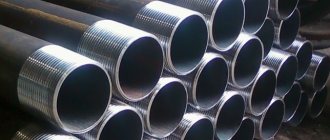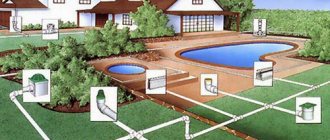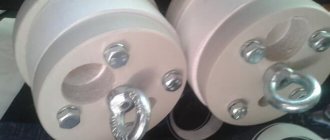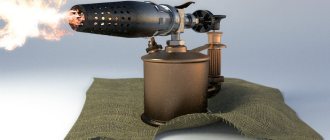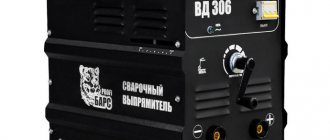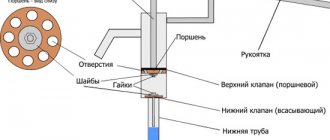The construction of a well source on a site is one of the main methods of obtaining water for residents of an individual house without a centralized water supply, while a casing pipe for a well made of various materials is used to create a water intake shaft. During drilling operations, pipes are connected into a column using various methods. The choice of installation method and shaft design is directly related to the technical characteristics of the well.
Although drilling is usually carried out by qualified specialists with extensive experience, any homeowner will benefit from information about the types of casing pipes, their dimensional parameters and technical characteristics, selection criteria, and casing installation technology. Since the diameter of the casing is tied to the size of the submersible electric pump used, which depends on the volume of water consumed, before drilling it is important to determine the model of the deep unit used.
Rice. 1 Scheme of water wells
Purpose
When drilling wells, a casing is always made of special pipes, which performs the following functions:
- The main purpose of the casing is to protect the mine from soil shedding and clogging of the borehole channel.
- The presence of a column makes it possible for the water column to rise upward without being absorbed into the ground, and prevents water pollution.
- Due to the tightness of the connection of the pipe sections, the casing protects the well source from the penetration of contaminated surface and ground water into its channel.
- It is convenient to immerse a deep-well electric pump that sucks up water into a smooth and rigid round trunk.
- A cap or cover is attached to the top of the column, which prevents external precipitation and dirt from penetrating into the channel and serves as a support for the safety cable of the deep-well electric pump.
- When connecting an adapter water supply, the casing pipe is a support for attaching the adapter, which is cut from the side into its wall at a depth below the freezing point.
- The filter, located at the bottom of the column, filters out large and small particles of gravel, sand, limestone, clay, making the water more suitable for drinking and household needs.
Rice. 2 Designs of casing steel pipes according to GOST 632-80
Casing requirements
The answer to the question, what is a casing pipe for a well, follows from its purpose. After drilling, the well shaft needs to strengthen the walls and form a straight channel to be able to lower a deep-well electric pump into the source. To do this, a casing is formed from various types of pipes, connecting them with threads, welding, and couplings.
Basic requirements for well columns and, accordingly, pipes:
- Rigidity and strength. The depth of domestic wells when drawing water from artesian sources reaches 200 m. At such distances, the pipe walls in the bottom area experience significant soil pressure. Therefore, the pipe shell must withstand this pressure without damaging the walls or changing the cross-sectional shape.
- Sealing of joints. Since the column is assembled from pipe fragments, during installation it is necessary to ensure their tight connection. Otherwise, water will leak from the well channel outside the column. This will lead to the formation of floaters and the penetration of dirt into the mine.
- Environmentally friendly. The vast majority of domestic wells are used for drinking water supply. Pipe material should not have a harmful effect on water, changing its chemical composition.
- Chemical inertness. During its entire service life, the casing pipe is exposed to water and aggressive soil conditions. Therefore, it is important that the pipe material is chemically neutral to avoid its accelerated destruction.
- Temperature resistance. The upper section of the casing from approximately depths less than 2 m from ground level falls into the zone of influence of the external environment. Its external temperature, if we take areas with extreme climatic conditions, can vary from - 50 °C to + 40 °C. The pipe material should not change its physical and chemical properties in a given temperature range.
- Long service life. The longevity of wells directly depends on their type. If a source on sand can be operated for an average of about 5 years, then the service life of an artesian reaches up to 50 years. Therefore, it is important that the casing of the artesian source can stand without destruction of the shell throughout this period.
Rice. 2 Metal casing
Article on the topic:
Autonomous water supply for a private house - instructions for arrangement . It may be interesting to read an extended article about the organization of water supply, the equipment used, diagrams, and calculations.
Types of casing pipes
Pipes used for casing wells must meet the requirements of strength, corrosion resistance, and withstand the temperatures of the surrounding and working aquatic environment. They should not change the chemical composition of the extracted water or saturate it with chemical elements harmful to human health. Their service life must exceed the operating time of the well source.
All casing pipes are divided according to materials of manufacture into the following categories.
Steel
The technical conditions for seamless steel pipes for casing wells with triangular and trapezoidal threads are regulated by GOST 632-80; according to this standard, they are produced in the following dimensional parameters:
- Outer diameter: from 114 to 508 mm.
- Wall thickness: from 5.5 to 16.1 mm.
- Length: casing pipe has dimensions from 9.5 to 13 m, for some categories lengths from 8.0 to 9 m are allowed, as well as sections less than 5 m at the request of the customer.
For the manufacture of metal pipes, steel of various grades is used; if they produce budget products, they use structural carbon steel of ordinary quality St2sp or St3sp (sp is a mild steel, higher quality than semi-calm PS or low-quality boiling kp). For the manufacture of expensive high-quality steel pipes with higher strength and corrosion resistance, structural carbon steel of ordinary quality grade St20 is usually used, a little less often St45.
Often, to increase the anti-corrosion properties, steel pipes of grades St3, St5 and St10 are galvanized and theoretically they can be used in the ground as an outer shell with a two-pipe casing (zinc is prohibited for direct transportation of drinking water). However, in practice, the use of zinc in the ground is not much different from ordinary metals, and the coating decomposes in the soil at the same rate as ordinary steel, which zinc is designed to protect.
Rice. 3 Dimensional parameters of steel pipes for wells according to GOST 632-80 with short triangular thread
Steel casing has the following distinctive features in comparison with other types:
- The main advantage of steel is its high compressive strength, bending strength, longitudinal and lateral loads, which is especially important when sinking mines to great depths.
- High-quality carbon steels St20 and St45 have a long service life due to their high corrosion resistance; as an outer shell in a two-pipe casing they can last about 20 years.
- Steel casing is not as sensitive to shaft drilling errors during installation as other less durable materials.
- When the bottom area of a water layer becomes silted, a heavy metal bailer is often used for cleaning, which is thrown into the mine from a great height. In a steel barrel there is no danger of damage to the walls of the inner pipe shell, which cannot be said about products made of polymers.
- A steel column has the highest cost of materials and installation.
Rice. 4 Cost of popular steel products
- The disadvantage of steel is its poor resistance to corrosion; because of this, steel pipes saturate the water with iron oxides, so they are not recommended for using drinking water in Abyssinian or sandy wells. The situation is different with artesian springs, the water in which often has a high content of ferrous salts and deferrization plants are used to normalize it. In this case, the use of steel pipes is more justified - a slight increase in the content of iron oxides in water due to metal corrosion will still be eliminated by the deferrization system.
- The high weight and length of steel pipes make it impossible to install the casing with your own hands; for these purposes, large-sized drilling equipment is used, which requires a large area of free space during drilling operations.
- Due to the large dimensions and weight, it is not always possible to install steel casing on a small area, much less inside a house.
Rice. 5 Technical characteristics of uPVC
Polymer pipes
Polymer materials occupy a leading position in many sectors of the national economy, and drilling equipment is no exception. The following products are sold on the construction market for use in well sources:
uPVC pipes . The main dimensional parameters and design of pipes made of unplasticized polyvinyl chloride PVC-U are regulated by TU 2248-001-84300500-2009, its main provisions:
- Average outer diameter: from 90 to 450 mm, for domestic wells the optimal values are 90, 113, 125, 140 mm.
- Wall thickness: from 5 mm to 23.5 mm.
- Length: any from 1 to 6 m with a multiplicity of 1 m, maximum deviation ±50 mm.
- Design:
- one end is bell-shaped with an internal thread, the other has an external thread.
- socketless straight pipe sections, one end with an external thread, the other with an internal thread, while the wall cross-section is increased.
- Permissible immersion depth: for products with any wall thickness up to 100 m, with a thicker wall the pipeline can be deepened to 300 m.
- Type of thread: conical thrust TRK, and trapezoidal TR.
Rice.
6 Dimensional parameters of uPVC according to TU 2248-001-84300500-2009 Plastic casing pipe for a well made of uPVC has the following performance properties:
- PVC-U is an environmentally friendly material and does not pollute water with the chemical elements it contains.
- The cost of polymer pipes is significantly lower than metal products.
- The standard color of the material is light blue.
- It is resistant to high mechanical loads such as impacts, compression and tension.
- Resistant to most aggressive chemical elements, allows well treatment with any components for regeneration and disinfection.
- High electrical insulating characteristics eliminate electrochemical corrosion of plastic, which is inherent in metals.
- The smooth and dense plastic shell prevents the formation of mold, algae, the accumulation of bacterial colonies, and the appearance of limestone on the walls.
- The polymer has hydraulically smooth walls that reduce resistance to water flow.
Rice. 7 Cost of uPVC
- Due to their lighter weight compared to metals, polymer pipes are easier to transport and install, and the installation speed is much higher than their steel counterparts.
- The service life of uPVC products exceeds 50 years.
- Unlike other polymers, uPVC has a density higher than that of water, so it sinks in it - this prevents any floating of the pipeline when it is in water layers.
- The uPVC pipe does not collapse when the water inside its channel freezes.
- Has the lowest coefficient of linear expansion compared to other plastics.
- The disadvantages of uPVC include the fragility of thin-walled products under lateral loads; in a well, this can lead to cracks in the casing during horizontal soil movements.
PVC pipes have similar parameters to uPVC products for the reasons that they are actually uPVC, and the manufacturer or seller unknowingly omitted the first letter in the product description.
Rice. 8 Dimensional parameters of PE pipes according to GOST 18599-2001 for different pressures
HDPE pipes. Polyethylene pressure pipes are produced in accordance with GOST 18599-2001; unlike PVC products, there is no separate standard for casing varieties of HDPE.
The main provisions of GOST 18599-2001 are as follows:
- The standard applies to pressure pipes made of polyethylene intended for transporting water for domestic, drinking and other purposes at its operating temperature from 0 to 40 ° C and pressure up to 2.5 MPa (25 bar).
- The diameter of PE pipes is from 10 to 2000 mm.
- Their length in straight sections is from 5 to 24 m with a multiplicity of 250 mm.
- The wall thickness depends on the operating pressure and diameter of the pipeline; its value ranges from several units to hundreds of millimeters.
- PE pipe has standard sizes for use in wells - 90, 110, 125, 140 mm.
- The HDPE pipeline has parameters similar to those of uPVC in terms of environmental friendliness, chemical and biological stability, and its service life is also 50 years.
Note: A significant difference between the material and uPVC is its low rigidity and high elasticity - this can lead to compression of the walls by soil when placing pipes at great depths.
PP pipes. Polypropylene pipes, despite the statements of many Internet sources, are not produced at all and are not used in casing strings due to the fragility of the material, its poor resistance to low temperatures and the destruction of PP when the shell is exposed to direct ultraviolet radiation.
Rice. 9 Technical characteristics of some brands of suspension HDPE according to GOST 16338-85
Casing made of other materials
In addition to the two options discussed above, in rare cases, casing columns are installed from the following materials:
Metals . Theoretically, it is possible to make a casing from welded cast iron, stainless steel, enameled pipes (another connection of these materials, such as a bell joint, is devoid of practical meaning, and the thread is technologically difficult to implement), but in real life such an assembly does not occur, since it has no technical application. This is due to the high cost of the work carried out, the complexity of installation and the low functionality of the resulting structure (for example, it is not clear how and what to make a filter in the bottom region of the column from).
Asbestos cement . The standard pipe connection of asbestos-cement pipes with rubber rings is not intended for use in vertical shafts; moreover, due to the fragility of the material and the complexity of installation, it is hardly technically possible to install an asbestos column.
Polymer pipelines . Industrially produced HDPE pipelines on reels and reels have a considerable length and high diameters, sufficient for use in wells. Using HDPE pipelines, casing is made in shallow Abyssinian springs for water intake by surface pumping stations from depths of no more than 9 m.
If you use HDPE pipes of large diameter at large depths, due to their elasticity and insufficient rigidity, the borehole channel will have low straightness, which will complicate the use of a submersible electric pump and increase the risk of it getting stuck in the mine. Theoretically, it is possible to use a continuous HDPE pipeline inside a casing made of rigid steel pipes, especially since the standard size of their outer diameter completely coincides with the polymer pipelines used in wells (90, 110, 125, 140 mm), but in practice no one has yet tried this idea took advantage of it.
Rice. 10 Cost and sizes of HDPE casing pipes
Installation of casing bored piles
Installation and installation of a pile foundation is carried out directly on the construction site. In principle, the technology for installing such a structure with your own hands is quite simple: you need to lower a pipe into the well, carry out reinforcement and concrete it. In length, such structures can be up to thirty meters with a diameter of up to one and a half meters, although with improved technical support, the length can be doubled and the cross-section increased to 3.5 m. With such parameters, the bearing capacity of bored supports will be 500 tons.
In most cases, the structure is buried 5 - 12 m with a diameter of 25 - 40 cm. Do-it-yourself assembly of metal structures is carried out according to the following scheme:
- The well is filled with concrete mortar per meter;
- the solution is compacted;
- the casing is gradually raised to the level when the concrete drops by 35 - 40 cm;
- this process must be repeated until the rod is completely filled with the mortar mass.
Pile design
The walls of the leader hole for the casing pipe during drilling become rough and loose due to collapsed soil, so a gap is formed between the hole and the metal structure, which is compacted with a solution, and the concrete, in turn, seeps into the soil structure and makes it stronger . This technology has one drawback, and it is that you cannot control the density of the concrete pour inside a long shaft. This minus can lead to erosion by groundwater of areas of the mixture that have not set, if there are any, of course.
The well for the pipe foundation is reinforced only in the upper part, while the reinforcement cage is buried 1.5 - 2 m into fresh concrete. Along with the casing pipe, the dry method is also used, suitable for stable and dense soils that can withstand the load without destroying the walls. The frame is installed in the well with your own hands, and then the mortar mass is filled. If bored wells are sunk into weak, watery soils without casing, then their walls must be reinforced with clay coating, the density of which must be at least 1.2 g/m3.
Well casing (single-pipe and double-pipe)
Depending on the depth of the wells, various casing methods are used, differing in the pipe materials used, installation technology, and dimensional parameters of the casing. All wells for individual water intake are conventionally divided into three categories, in which the following well installation methods are used.
Abyssinian . The sources are designed for water intake from surface underground water layers; the depth of the shaft rarely exceeds 30 m, so the soil pressure on the walls of the column is insignificant. If a surface pumping station is used with a pressure pipe immersion depth of no more than 9 mm, instead of a column of individual pipes, use a long piece of HDPE pipe of suitable diameter on a reel.
If the water surface is below 9 m from the surface of the earth, a submersible electric pump is placed in the well. To install the column, use a thick-walled plastic pipeline made of low-pressure polyethylene HDPE or a thin-walled one made of unplasticized polyvinyl chloride PVC-U.
Since the flow rate of the Abyssinian well is not too high, to save money, it is rational to use a medium-power submersible electric pump with a diameter of 3 inches (75 mm) and you can use polymer pipes with a small transverse size.
It is rational to choose the outer diameter D of the well pipeline for the size of this 3-inch electric pump as a standard value of 90 mm (the bore diameter of the channel Dn is equal to 80 mm). It should be noted that a gap of 5 mm, taking into account errors in pipe manufacturing, is the limit, therefore these casings are used with transverse dimensions of electric pumps no more than 75 mm (suitable for Grundfos SQ with Dn=74 mm, Aquario ASP with Dn=75 mm) or choose the next, higher pipe size (the best option is outer diameter D = 110 mm with a wall thickness of 7 or 9 mm).
Rice. 11 Casing options
Wells in the sand . The depth of sand wells reaches 70 m, so the column experiences stronger soil pressure. Also, the flow rate of sand wells is higher than that of Abyssinian sources - this requires the use of more powerful electric pumps with a standard diameter of 4 inches (100 mm).
PVC-U polymer pipes with thick walls are suitable for equipping a borehole; the permissible installation depth does not exceed 100 m. The optimal option for placing 4-inch electric pumps is a pipe with an outer diameter of 125 mm; with a wall thickness of 7 or 9 mm, its bore diameter Dn will be equal to 111 or 107 mm respectively.
Artesian wells. Artesian underground springs are considered the deepest; in domestic wells, the distance from the surface of the earth to the water basin can reach 200 m. Therefore, strong steel pipes are used for their installation, but due to the fact that they are susceptible to corrosion, a corrosion-resistant polymer pipeline is usually inserted into them. Double-pipe well casing can withstand significant external loads and is optimal from the point of view of financial savings - the service life of artesian wells reaches 50 years, so the column should have a similar longevity.
For external piping, from the point of view of corrosion resistance, steel pipes with a high carbon content made of high-quality steel grade St20 or St45 are well suited; they can also be used directly in a well source with drinking water with high wall thickness.
It should be noted that, according to GOST, polymer and steel pipes have consistent transverse dimensions for organizing double casing: if you choose the diameter of casing pipes for wells made of steel D = 140 mm, according to the table in Fig. 3 for a 7 mm wall we get the internal dimension Dn = 125.7 mm - this space is perfect for installation inside a polymer pipe with a diameter of D = 125 mm.
If the depth of the artesian well does not exceed 100 m, you can use cheaper double casing with HDPE or PVC-U polymer pipelines; in any case, it is better to leave the final decision to experienced specialists from organizations that drill and tie up well sources.
Rice. 12 Types of pipe connections
Advantages and disadvantages of the method
The technology of percussion-rope drilling of wells has many advantages over other methods:
- Using this method, it is possible to qualitatively open the aquifer and exploit it. The service life of the well exceeds 50 years;
- When drilling using the percussion method, you do not need to use water or special drilling fluid. It's very practical;
- using this method to form a well, you can even drill into rock that very easily absorbs the flushing liquid;
- You can start operating the well immediately after completing the entire range of work;
- The impact drilling method does not pose a danger to the aquifer. After carrying out the entire complex of work, its clogging is excluded;
- Do-it-yourself impact drilling of wells is carried out with the formation of a hole with a large initial diameter;
- With the help of this drilling rig it is possible to carry out geological exploration work. The rock is excavated throughout its entire depth.
Connection types
When arranging the casing, pipes are connected into a column in the following ways:
Socket threaded . The method is used when joining polymer or metal thin-walled pipes, while an internal thread is cut in the socket, and an external thread is cut in the section of the outer shell of the connected pipe.
Threaded. They are used in thick-walled metal and polymer pipes; the connected elements have external and internal threads; when they are joined, the walls are smooth on the outside and inside.
Coupling. The pipe elements to be connected have an external thread; they are screwed into a connecting coupling with an internal thread until the ends are connected.
Electric welding. Welding can be useful when joining thin-walled steel pipes where the cut threads would be too weak. The welding method is often used when installing steel casing - although it takes some time and requires good welding skills from a specialist, its use can be cost-effective (no need to purchase expensive heavy pipes with threads and thick walls).
Rice. 13 Steel and HDPE casing pipes
How we are working?
If you notice irregularities in the operation of the well, you need to contact specialists as soon as possible to determine the causes of the malfunction. Long-term operation in emergency mode can lead to breakdowns that cannot be repaired.
- After contacting our company with a description of the problem, our technicians go to the site.
- Using video logging, they determine the cause and decide how to carry out repairs.
- An estimate and contract for the work is drawn up.
- At the agreed time, specialists arrive to carry out repairs.
- The finished object is handed over to the customer with the signing of the acceptance certificate, payment for services and issuance of a guarantee for the work.
If you need well pipe repair, contact our company:
- We employ educated and qualified specialists.
- The company's material and technical equipment allows it to cope with any task.
- Work is carried out all year round, in any weather.
- We understand the level of responsibility of our work, so we do it conscientiously.
- Our many years of experience allow us to eliminate faults of any kind in a short period of time.
To call a specialist or get advice, call us at the numbers listed on the website, or leave your written request.
Criterias of choice
To arrange the casing, you must have the following information: well depth, volume of water supply, diameter of the submersible electric pump, and the choice is also greatly influenced by the consumer’s financial resources. To determine which pipe is best for a well, consider several options for well sources for water supply.
- For water intake using a submersible electric pump from a shallow well (up to 30 m) of the Abyssinian type, it is best to use a polymer pipeline made of uPVC. Depending on financial capabilities, choose thin-walled products with a threaded socket connection or thick-walled ones with versatile external and internal threads.
- For wells in sand up to 60 m deep, a good option is thick-walled uPVC; for further depths up to 100 m, you can consider various methods with double casing made of polymers. A good option is to use a rigid PVC-U pipeline on the outside, and an elastic and less load-resistant HDPE shell on the inside.
- For depths above 100 m, it is rational to use a rigid metal casing, inside of which an elastic HDPE or rigid PVC-U pipeline can be placed.
Rice. 14 Appearance of PVC-U pipes
- In any case, when choosing a single-pipe or double-pipe casing, the composition of the soil, geological factors, and groundwater levels should be taken into account. It wouldn’t hurt to listen to the feedback of highly qualified specialists on the issue of casing.
- When purchasing HDPE products, you should be careful because the retail chain sells recycled technical polyethylene and food-grade primary material. Their main easily distinguishable difference is the color: a pipe made from recycled granules usually has a dark blue or rich blue color, sometimes there is a green tint. HDPE products made from primary raw materials, in accordance with GOST, have a bright blue or light blue color.
- Another criterion for determining a low-quality HDPE product is the smell of plastic. Oon may resemble the aroma of confectionery products, detergents, washing powder, etc. - all this indicates that the material is made from recycled granules. Pure virgin polyethylene is odorless and can be used in drinking water systems without harm to human health, while polyethylene from recycled materials can be used in water intake systems for technical needs.
- When choosing the diameter of the column, they are guided by the flow rate (performance) of the source and the dimensional parameters of the electric pump; for large volumes of water intake, they try to increase the diameter of the casing. The pump is selected so that its diameter is not less than 5 mm of the internal diameter of the wellbore; if a soft HDPE pipeline is used or water intake is carried out at great depths, a larger internal diameter of the column is selected taking into account the deformation of the channel when compressed by soil.
- The quality of a PVC-U threaded connection is determined as follows: screw a pipe into another or its branch pipe three turns and then move one of the parts to the sides - a large gap indicates a weak fastening. Such a connection has low tightness, and if it is necessary to dismantle the casing and remove the string from the wellbore, the thread will most likely be torn off.
Rice. 15 Well filters and cone plug
Application for water wells
When drilling water wells, three types of casing pipes are used: plastic, steel and asbestos-cement. In order to save money and simplify installation, it is recommended to use plastic casing (PVC or NVVC).
Installation of casing pipe is carried out when constructing water wells to any depth. The insertion of the casing is performed upon completion of drilling of the cavity. Composite pipes are used, joined by means of a threaded connection.
The diameter of the casing pipe and the well itself is selected based on the required productivity of the source. The section of the casing must be such that a drainage pump can be placed in it. The lower sections of the casing are made of perforated products, the holes of which are blocked by a mesh filter.
There is a lot of debate about which pipes are better to use for casing water wells - steel, asbestos-cement or plastic. The key disadvantage of metal products is their tendency to corrosion, which can cause a characteristic taste of rust and the presence of sediment in the water, for the purification of which you will have to buy expensive filtering equipment, and the iron products themselves are much more expensive than their analogues.
Asbestos cement casing pipes are a budget solution, the disadvantages of which are the large thickness of the walls, which reduces the useful volume of the well, as well as questionable sanitary suitability (there are studies indicating that asbestos cement is a carcinogen).
In general, asbestos-cement products can be used for casing wells subject to the following conditions:
- when constructing an artesian well (such a pipe cannot have perforations, which makes it impossible to install a filter column in sand wells);
- if there is a hygienic certificate for the product.
In terms of overall performance qualities, plastic casing pipe is best suited for water wells. Such products are easy to install, cheap, corrosion-resistant and durable (service life up to 50 years).
Plastic casing for water wells
Four types of materials can be used for the manufacture of plastic casing pipes:
- PVC – polyvinyl chloride;
- uPVC is an unplasticized type of polyvinyl chloride;
- HDPE – low-density polyethylene;
- PP – polypropylene.
The most popular products are uPVC products. Unlike standard PVC products, uPVC pipes are classified as pressure pipes - they have greater mechanical strength and resistance to deformation, which allows them to be used in wells up to 300 m deep.
Plastic casing pipes made of PVC and uPVC for water wells are produced in the following standard sizes:
- Diameter 90 mm, wall thickness 5 mm;
- DN 110, thickness 6.3 mm;
- DN 125, thickness 7.6 mm;
- DN 140, thickness 10 mm;
- DN 165, thickness 12 mm.
Most often, pipes with a diameter of 90 and 125 mm are used, since most modern borehole pumps are produced for this size.
Pipe sections (length 3-12 meters), depending on the design features, can be joined into the casing in two ways - using a thread or a socket. The greatest reliability and tightness of the casing is ensured by a threaded connection, which is easy to assemble with your own hands, however, products with threads are more expensive than analogues with a socket.
The leading domestic manufacturer of polymer casing pipes made of PVC and uPVC is the Cormell company, which supplies the market with products of all common sizes. In addition to the Cormell company, the products of the companies SPT, Bix and Omega have also proven themselves well.
Drilling a well with casing
Drilling wells and installing casing if you have the appropriate equipment and technology does not seem to be a very complicated process; the most common sand wells go as follows:
- A drilling rig is driven into the site, after determining the location of the well, the equipment is turned on and with a drill of the appropriate diameter attached to a rod of a standard length of 3 - 4.5 - 6 m, excavation begins. As the rods deepen, they lengthen them by screwing the following elements onto the threads, thus immersing the drill to the required depth until water appears.
- Almost all tunnelers use hydraulic drilling technology, directing water from the tank of an auxiliary machine (water truck) into the wellbore during drilling. Water is supplied to the mines through hollow rods; the second method is to construct a small pit at the excavation site, which is constantly replenished with water; it is used in low-cost excavation.
- After the required sand or limestone appears in the dump (depending on the type of well), the rods are removed and dismantled one by one, then the drill is removed, replacing it with a downhole uPVC filter. The filter device is a regular factory-made pipe with transverse slots (slit filter); many drillers make it themselves by perforating a series of round holes in the casing pipe and wrapping the casing with a fine-mesh mesh made of metal corrosion-resistant materials (stainless steel, bronze, brass and copper alloys).
- A conical plug is attached to the end of the filter using threads or self-tapping screws, after which it is lowered into the borehole channel. Before installing the column, crushed stone and river sand are sometimes poured into the bottom of the well to organize additional filtration.
- As it lowers, the next pipe is screwed to the filter and so on until the desired level is reached.
- After installing the column, the upper pipe is cut off and the well is pumped, supplying water under pressure into its channel for some time, after which they begin pumping out the muddy water with a submersible electric pump until a clear liquid appears at the outlet.
- The complete pumping procedure can take several days, but experts aim to complete the job in a few hours, counting on the sedimentation of suspended particles to the bottom over time.
Rice.
16 Examples of do-it-yourself drilling work For the construction of wells, casing pipes made of unplasticized polyvinyl chloride (UPVC), which have high physical and chemical characteristics, a long service life, and lower cost compared to metals, are currently widely used.
The use of uPVC casing makes it possible to effectively equip all types of wells with a depth of 5 to 300 m with convenient placement of water intake submersible electric pumps of any model.
Well on site
- the presence of aquifers accessible for drilling;
- physical properties of soil rocks;
- type of drilling tool;
- the length of the casing, depending on the depth and direction of the well shaft.
After a geological survey of the area, the owner makes one of the following decisions:
- rent a UKB cable drilling rig and carry out the work on your own;
- hire a specialized team.
For independent actions, you can make a tripod of your own design. The triangular pyramid is made from available materials - wooden beams or metal profiles. You will need to stock up on a lifting mechanism to lower the casing pipe into the well and manipulate the projectile. The height of the drilling tower is determined by the size of a single casing fragment.
For the oil and gas industry
The main area of use for casing pipes is the oil and gas industry. For oil or gas wells, large diameter metal casing pipes are typically used (the material typically used is a strong variety of steel). This choice is determined by the fact that plastic shows rather poor performance in terms of strength when working at great depths.
Oil and gas casing pipes are usually 10 to 15 meters long. Special threaded parts are used to connect to each other - this allows you to obtain durable structures with a high degree of sealing, which avoids leaks in case of wear. At great depths at pressures of more than 30 MPa, each element must be equipped with a rubber seal.
Please note that according to GOST, pipes of various diameters must have a certain wall thickness to ensure reliable and safe operation in the well (there is a possibility of damage to individual elements under the influence of excess pressure that is naturally formed in the well).
Table of correspondence between wall thickness and diameter:
| Diameter in centimeters | Wall thickness in centimeters |
| 42,5 | from 1 to 1.5 |
| 32,5 | from 0.9 to 1.3 |
| 19,5 | from 0.8 to 1.2 |
| 12,5 | from 0.6 to 1.1 |
